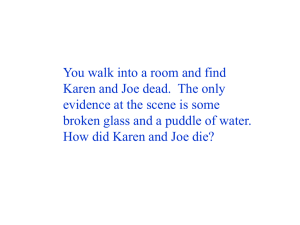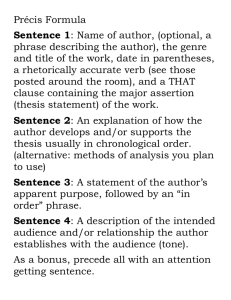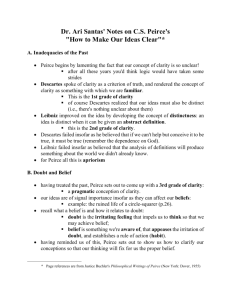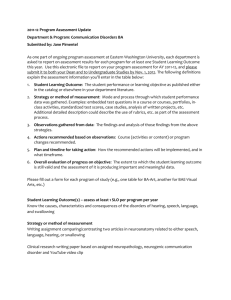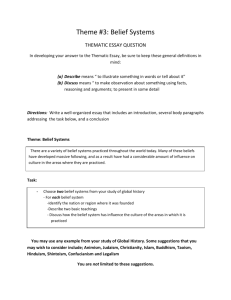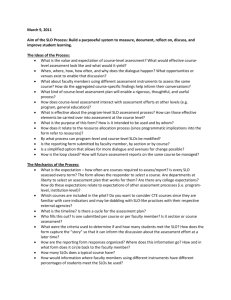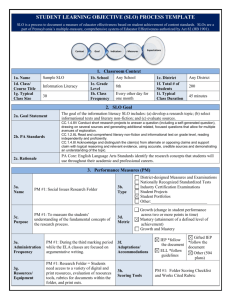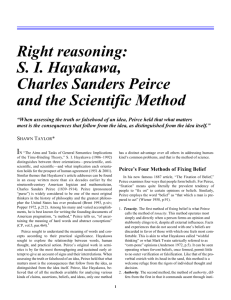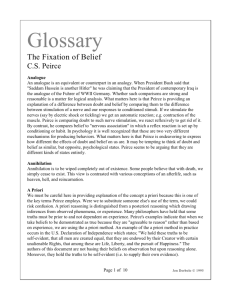English 1A
advertisement
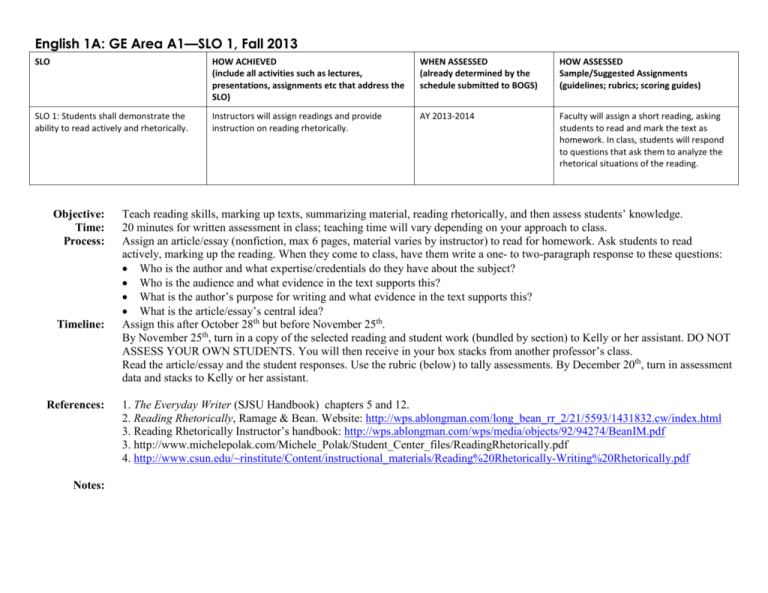
English 1A: GE Area A1—SLO 1, Fall 2013 SLO HOW ACHIEVED (include all activities such as lectures, presentations, assignments etc that address the SLO) WHEN ASSESSED (already determined by the schedule submitted to BOGS) HOW ASSESSED Sample/Suggested Assignments (guidelines; rubrics; scoring guides) SLO 1: Students shall demonstrate the ability to read actively and rhetorically. Instructors will assign readings and provide instruction on reading rhetorically. AY 2013-2014 Faculty will assign a short reading, asking students to read and mark the text as homework. In class, students will respond to questions that ask them to analyze the rhetorical situations of the reading. Objective: Time: Process: Timeline: References: Notes: Teach reading skills, marking up texts, summarizing material, reading rhetorically, and then assess students’ knowledge. 20 minutes for written assessment in class; teaching time will vary depending on your approach to class. Assign an article/essay (nonfiction, max 6 pages, material varies by instructor) to read for homework. Ask students to read actively, marking up the reading. When they come to class, have them write a one- to two-paragraph response to these questions: Who is the author and what expertise/credentials do they have about the subject? Who is the audience and what evidence in the text supports this? What is the author’s purpose for writing and what evidence in the text supports this? What is the article/essay’s central idea? Assign this after October 28th but before November 25th. By November 25th, turn in a copy of the selected reading and student work (bundled by section) to Kelly or her assistant. DO NOT ASSESS YOUR OWN STUDENTS. You will then receive in your box stacks from another professor’s class. Read the article/essay and the student responses. Use the rubric (below) to tally assessments. By December 20th, turn in assessment data and stacks to Kelly or her assistant. 1. The Everyday Writer (SJSU Handbook) chapters 5 and 12. 2. Reading Rhetorically, Ramage & Bean. Website: http://wps.ablongman.com/long_bean_rr_2/21/5593/1431832.cw/index.html 3. Reading Rhetorically Instructor’s handbook: http://wps.ablongman.com/wps/media/objects/92/94274/BeanIM.pdf 3. http://www.michelepolak.com/Michele_Polak/Student_Center_files/ReadingRhetorically.pdf 4. http://www.csun.edu/~rinstitute/Content/instructional_materials/Reading%20Rhetorically-Writing%20Rhetorically.pdf Rubric for 1A SLO 1 SLO 1: Students shall demonstrate the ability to read actively and rhetorically. Exceeds Meets Fails Answers each question individually. May lack transitions between questions. May have minor errors in content such as misspellings of author’s name, credentials, topics, etc. or minor errors on the content. That is, the interpretation of the reading has to be generally correct, but you should allow for slight misinterpretations like recognizing the author as an expert but not knowing specifics about the author. The author was a mathematition and philosopher who studied chemistry. He wrote an article to educated people because he uses alot of technical terms and references people like Darwin. His purpose was to make people think about our beliefs and he backs this claim up with descriptions of four beliefs, pointing out the pros and cons of each belief. He also wants to point out the ways that people make their beliefs so the reader thinks about their own beliefs. The article made me think about my own beliefs and why I think the way I do. Fails to answer all questions. Answers are factually incorrect (e.g. gets the author’s credentials wrong, misreads the text). Will likely misinterpret an included/cited opposing argument as the author’s point. Examples Based on “The Fixation of Belief” by Charles S. Pierce This is an essay not likely taught in any of our courses. (Please do not assign this to your students.) Available: http://www.peirce.org/ writings/p107.html Excerpt adapted from: http://oregonstate.edu/instruct/ phl201/modules/ rhetorical-precis/ sample/ peirce_sample_precis_click.html Answers all questions in a unified paragraph or two. Answers flow smoothly; uses transitions effectively. Will provide clear evidence to support audience and purpose. Direct quotations are NOT required. Scientific philosopher and mathematician, Charles S. Peirce asserts that humans have psychological and social mechanisms designed to protect and cement our beliefs. Peirce backs this claim up with descriptions of four methods of fixing belief, pointing out the effectiveness and potential weaknesses of each method. Peirce's purpose is to point out the ways that people commonly establish their belief systems in order to jolt the awareness of the reader into considering how their own belief system may the product of such methods and to consider what Peirce calls "the method of science" as a progressive alternative to the other three. Given the technical language used in the article, Peirce is writing to a well-educated audience with some knowledge of philosophy and history and a willingness to other ways of thinking. Note: This example has grammar errors and is stilted, but it covers the rhetorical analysis enough to pass. 1. The article was about how we believe things. The author wrote to university students who are studying philosophy, so the author probably studied philosophy. 2. The author was a philosopher who wrote about why we believe what we believe. He wrote to intelligent people because he used all sorts of complicated phrases and old language. He wrote about Darwin and other scientists and their theories. He wanted his readers to think about science more than what we believe because what we believe is just a belief and not really fact. Note: The 2nd example fails because the explanation is vague, the audience explanation is weak, and the summary is not focused on the central idea. **Note: This SLO assessment has nothing to do with grammar or mechanics. Do not assess the writing based on these errors. Assess on content. Assessment totals (Use tally marks or another system to help you total students; you keep this form.) Exceeds _________ Meets __________ Fails __________ TOTAL ASSESSED __________
